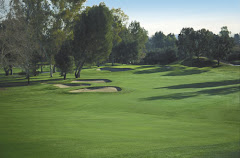
Our first frost of the season was on December 14th, about 3 weeks later then normal. Since this day we have made up for the lack of frost by having frost on 21 of the last 24 days. Two of the days with out frost it was raining.
Frost occurs when the soil surface is 32 degrees or below, causing dew to freeze on the turf. The ice crystals that form are lovely to look at, but are also the most serious hazard to the health and appearance of turf during the winter months. Frost produces a silvery sheen on turf as is illustrated in the photo above.
Frost by itself does not necessarily cause damage to turf. However, when weight is applied to frosted turf in the form of foot or vehicular traffic, damage will result. This is because frost transforms turf from a s soft, springy surface to a fragile, brittle surface that cracks when pressure is placed on it.
All types and heights of turf can be damaged by frost, not just putting greens.
Golf cart traffic on frosty turf results in damage that appears 2-3 days later. Walking on frosty greens also produces foot shaped patterns of brown, dead turf. In both cases, turf is slow to recover, leaving unsightly brown areas for weeks or even months.
Frost is frequently an early morning problem that is relieved once the sun comes up and air temperatures rise. Once frost crystals melt, turf is safe for foot and vehicular traffic.
There is really only one way to avoid frost damage, and that is to avoid all traffic until it has melted.








1 comment:
Hi Robert, great report on frost. Now I know.....
I have an idea for a future post, which I did not see in the archive but maybe I missed. How about a couple of comments on working the range. Specifically about the right "pro" way to take divots. Sometimes I see 10 divits scattered over a square yard and I think "what a waste." Then I see how the guys in the shop take divots. How about fixing each type from your end and taking care of our range? Jim Armstrong
Post a Comment